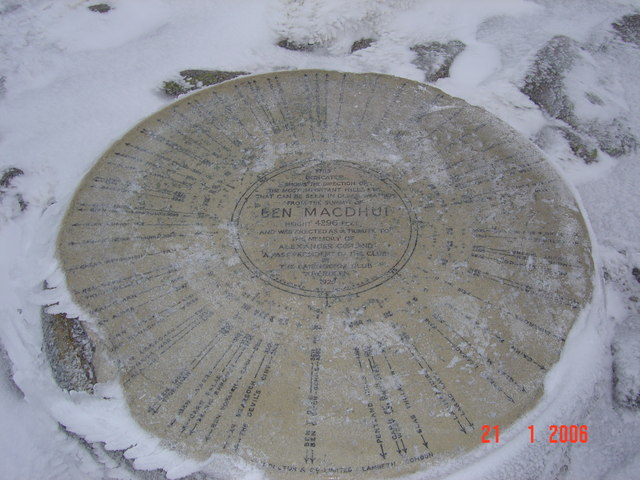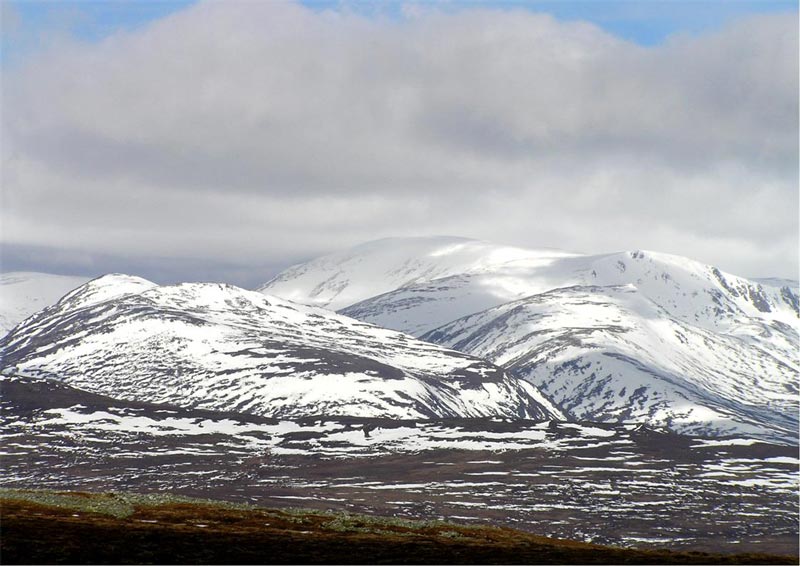If you think of mountains and mysterious creatures, your mind probably turns to the Abominable Snowman. Especially if you’re thinking about humanoid figures half-glimpsed in treacherous conditions. Yet you may not immediately think of the Grey Man of Ben Macdui.
Ben Macdui (also spelt Ben MacDhui) is the second-highest mountain in Scotland after Ben Nevis. It lies among the Cairngorm mountains in the eastern Highlands. A favourite with climbers, it’s also believed to be the home of the mysterious Grey Man.

The first recorded encounter appears in 1925, making it a surprisingly late addition to the canon of mysterious creatures and supernatural figures haunting the landscape of the British Isles. The inconclusive evidence also means that debates over the Grey Man’s existence continue.
Let’s go and dig into the stories, eh?
The First Official Encounter
One of the first people to admit to an encounter with the Grey Man was scientist and mountaineer Professor J. Norman Collie. His experience happened while climbing Ben Macdui in the Cairngorms in 1891, but he didn’t relate it to anyone until 1925. He revealed his experience as part of a speech that marked the first official record of the strangeness in the Cairngorms.
According to Collie, he’d reached the cairn at the summit alone one misty day. He suddenly realised he could hear noises besides his own footsteps. If he took a few steps, he heard a crunch behind him, as though someone was following him with longer strides. He saw nothing, thanks to the mist, but ran down the slope towards Rothiemurchus Forest, some four or five miles away (The Newsroom 2005).

Due to Collie’s reputation and respectability, other climbers came forward to relate their tales. Fear of ridicule prevented them from saying anything sooner, but Collie’s admission legitimised what they’d experienced.
That said, Collie’s biographer, Christine Mill, described him as a lifelong occult believer. He often told tall tales of gods and legendary creatures around the campfire. Who’s to say the Grey Man wasn’t simply another of these fantastical stories? Some sceptics have also claimed that Collie admitted making up the story, having not been given notice that he was expected to speak at a climbing club dinner (Gray 2013 [1970]).
The Grey Man Strikes Again
One climber named Peter Densham climbed Ben Macdui in May 1945. The day started clear, although mist closed in while he sat at the summit. Densham dismissed the strange noises in the mist, assuming them to be related to the rocks moving, and set about enjoying his lunch.
Eventually, he felt pressure on his neck, before hearing a crunching from his left. He moved forwards to investigate, at which point he was overcome by apprehension. The desire to leave the mountain prompted him to break into a run. Strangely, he found himself running towards one of the cliffs, describing the sensation “as if somebody was pushing [him]” (Gray 2013 [1970]). Thankfully he changed course and ran down the side of the mountain to safety.

In a second encounter, Densham was on the mountain with another man, Richard Frere. While on mountain rescue duty, he and Frere found themselves on the summit of the mountain. Frere started talking to someone, and Densham assumed this ‘someone’ was hidden by the cairn at the summit. Densham joined in the conversation, and after a while, they realised they were the only ones there. Neither could recall the content of the conversation—only that it had happened (Gray 2013 [1970]). While Densham had no further experiences, he believed he’d had psychic interactions with something on the mountain.
Other Encounters
Two climbers told author Alastair Borthwick about their experiences on Ben Macdui. Borthwick immortalised the accounts in his 1939 book about climbing, Always a Little Further.
The first man experienced the same crunching footsteps as Collie. Again, he could see very little due to the mist. He also reported a “crinkly feeling in the back of my neck”, and swiftly left the summit. Apparently, the footsteps stopped around a thousand feet before he reached the Larig (Undiscovered Scotland 2000-2021).
The second climber reported something similar. Again, he couldn’t see for the mist, though he heard the same footsteps. The difference came when the mist cleared. The footsteps stopped only a few years behind him. The mist suddenly lifted and the climber realised he was alone on the mountain (Undiscovered Scotland 2000-2021).

One weird thing does characterise these two accounts. Both mention that the footsteps were irregular. The first climber thought he heard one footstep for every three of his own. The second said it was once for every 2.5 of his own. Yet the second man was 6ft, while the first was only 5ft 7ins (Undiscovered Scotland 2000-2021).
Another sighting appeared in the 1958 issue of The Scots. Alexander Tewnion claimed the sighting from 1943. According to him, he was thinking of the figure when the mist rolled across the summit, having heard of Collie’s encounter. A shape charged at him, and he pulled out his revolver. He fired three times but it didn’t deter the figure. Tewnion eventually fled, though he did admit that he’d never had another encounter despite frequent visits to the mountain (May no date).
What does the Grey Man look like?
Most agree the figure is around 10ft tall, covered in hair, with long legs, talons, and pointed ears (The Newsroom 2005). Comparisons with the yeti are inevitable. Some witnesses also claimed the creature wore a top hat when they saw it. Others described the crunching footsteps heard by Collie or mentioned singing or ghostly laughter (The Newsroom 2005).
Climbers also report feeling a presence more often than they see one. Apparently, the atmosphere is pervaded by a sense of terror, despair, and negativity (The Newsroom 2005). So while the more ‘famous’ encounters don’t include a sighting, it’s remarkable that those that do often agree.
Still, the fact that encounters often happen in misty conditions clearly makes visibility difficult.
So how do we explain the Grey Man of Ben Macdui?
Some people go with the ‘usual’ explanation that he’s a type of yeti or big-foot. This would put him into the same category as the Abominable Snowman or Bigfoot. As always, there are issues with this explanation, such as life span and an apparent lack of mating partners.
Another explanation involves aliens. Because of course it does.
Yet a third refers more to the area than the creature itself. In this theory, Ben Macdui becomes a liminal point between two worlds. The Grey Man thus becomes a guardian to prevent people from wandering between the two (The Newsroom 2005).
Another theory sees the Grey Man as a “manifestation of the spirit of the mountain created psychically in the viewers’ mind” (May no date).
More Mundane Theories
Other explanations are far more mundane. These range from optical illusions, a quirk of geology, or even hallucinations caused by the altitude. Remember, no photographs exist of the Grey Man. Even footprints turned out to be a phenomenon caused by the interaction of rain and snow. Shirley Cunningham also makes the point that the unearthly cries could come from cock ptarmigans, rather than the Grey Man (1985: 7).
One particular phenomenon is that of Brocken Spectres. This happens when a climber’s shadow ends up cast across a lower level of cloud. Magnified and distorted by the atmosphere, it can cause people to see figures where there are none (Undiscovered Scotland 2000-2021).

A sighting involving this explanation actually dates back to 1791. Poet James Hogg saw a figure “at least thirty feet high” standing near to him while he tended sheep on the mountain. He ran home, but the next day, the same thing happened. This time, he was struck more by curiosity than fear. He took off his hat and the figure copied his movement. Hogg realised it was just a shadow in the fog. This phenomenon had been first observed in Germany’s Harz Mountains on the Brocken, one of the peaks, in 1780 (May no date).
Before we get too excited, The Scotsman wants to remind us of this. Walkers in the Black Forest in Germany reported misty grey men and echoing footsteps. People complained of being followed through the forest. And they were—by their own shadows (2005).
What do you think?
If there is something on the mountain, then it would seem more spectral or psychic in nature. That would explain why it seems to manifest through sound or feelings of dread, rather than visual sightings. A spectral entity would also sidestep the problems typical to Bigfoot stories—as in, how old would the creature need to be and where did it physically come from? We see these issues around breeding populations with the tales of British big cats.
Of course, it’s also possible that there isn’t something on the mountain. Perhaps it really is just tricks of the light, the conditions at the summit, or good old-fashioned psychology. It’s possible that Collie did invent the story, which other people used to rationalise an otherwise weird experience they’d had. And thus the legend was born.
I’d love to know what you think! Do you think the Grey Man of Ben Macdui is out there? Or do you think it’s just a combination of rational factors that people interpret as the Grey Man? Let me know in the comments!
References
Cunningham, Shirley (1985), ‘A long, hard slog over Larig Ghru’, Aberdeen Press and Journal, July 13, p. 7.
Gray, Affleck (2013 [1970]), The Big Grey Man of Ben Macdhui, Edinburgh: Birlinn Ltd.
May, John (no date), The Gray Man of Ben MacDhui’, Scotia News, issue 83, http://userhome.brooklyn.cuny.edu/anthro/jbeatty/Scotia/issue83/issue83a.html.
The Newsroom (2005), ‘The Big Grey Man of Ben MacDui’, The Scotsman, 7 March, https://www.scotsman.com/arts-and-culture/big-grey-man-ben-macdui-2507058
Undiscovered Scotland (2000-2021), ‘AM FEAR LIATH MÒR, THE BIG GREY MAN’, Undiscovered Scotland, https://www.undiscoveredscotland.co.uk/usscotfax/outdoors/greyman.html.
Nutty about folklore and want more?
Add your email below and get these posts in your inbox every week.
You'll also get my 5-step guide to protecting your home using folklore!








Have your say!